Task Manager is used to manage the running tasks on a system. In Ubuntu 22.04, the “System Monitor” performs the function of a task manager, which controls all the processes, CPU load, and Hard disk consumption. By monitoring the tasks, we can also end, kill, stop and continue the process from the Task Manager.
Task Manager is a powerful system managing tool that allows you to show the running processes, manage processes, CPU consumption, and much more. In this guide, we will elaborate on the usage and working of Task Manager (System Monitor) in Ubuntu 22.04. The content of the guide is as follows:
- How to Use the Task Manager in Ubuntu 22.04?
- Use Task Manager For Monitoring System Processes
- Use Task Manager For Monitoring System Resources
- Use Task Manager For Monitoring File Systems
Let’s start the guide!
Prerequisites: Install Gnome System Monitor
Ubuntu 22.04 comes with built-in support of System Monitor (Task Manager). If you don’t have it in your system, you can install the Task Manager using the command:
$ sudo apt install gnome-system-monitor
Let’s start using it:
How to Use the Task Manager in Ubuntu 22.04?
To use a Task Manager, we must know how to open it. We can open the Task Manager in Ubuntu using the CLI and GUI.
Clicking on “Show Applications”; a search menu will open. Search “system monitor” in the search bar and click on the application to open it:
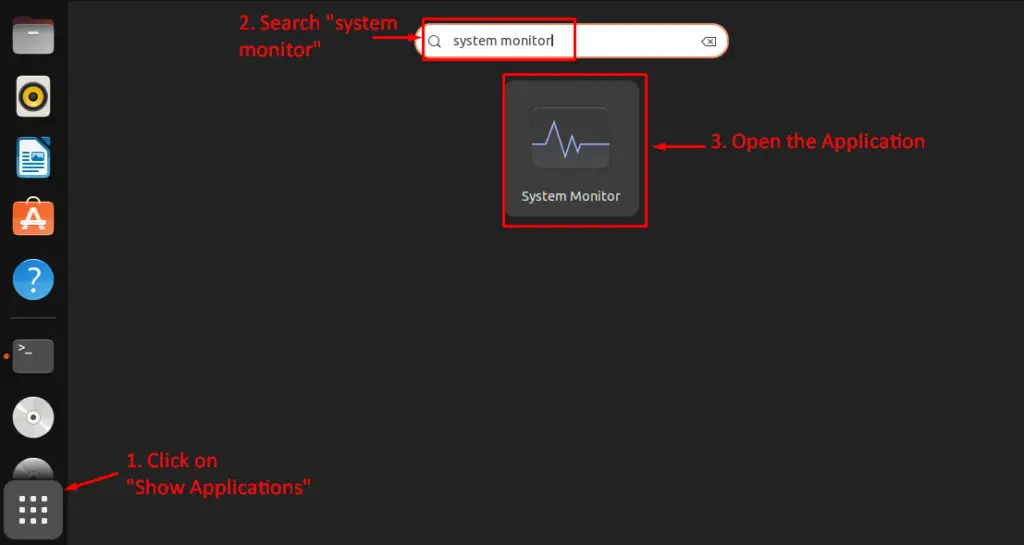
Or run the following command in the terminal:
$ gnome-system-monitor
The following interface will appear either after you have opened it from GUI or using the command:
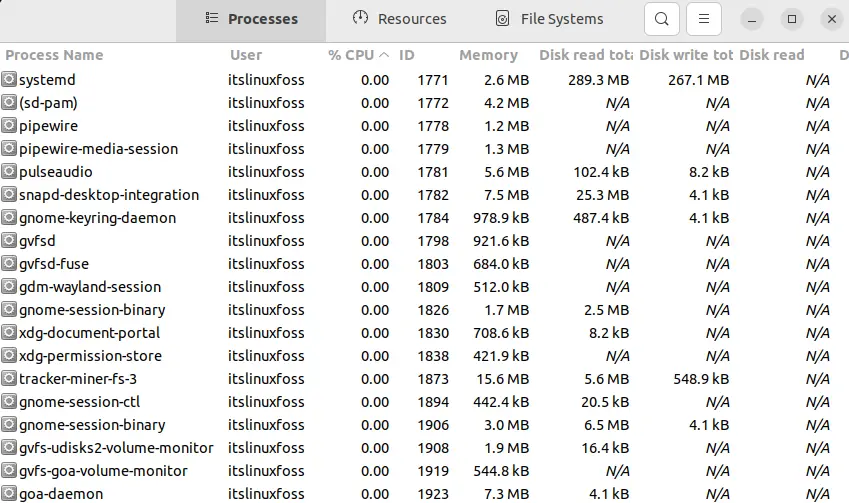
Now, we can use the Task Manager in Ubuntu 22.04 for monitoring the following system functions:
- Use Task Manager For Monitoring System Processes
- Use Task Manager For Monitoring System Resources
- Use Task Manager For Monitoring System File Systems
Let’s start from the first one:
Use Task Manager For Monitoring System Processes
A process is a program that runs and operates the system. The program processing requires CPU and memory usage. When you open the Task Manager, the “Processes” tab shows where the currently running tasks are listed. The processes show all the active “Process Name” with detailed information like user, %CPU, Memory, the ID of the process, and other details related to that system.
Inside the Process monitoring feature, the users will get the same information tabs as discussed here.
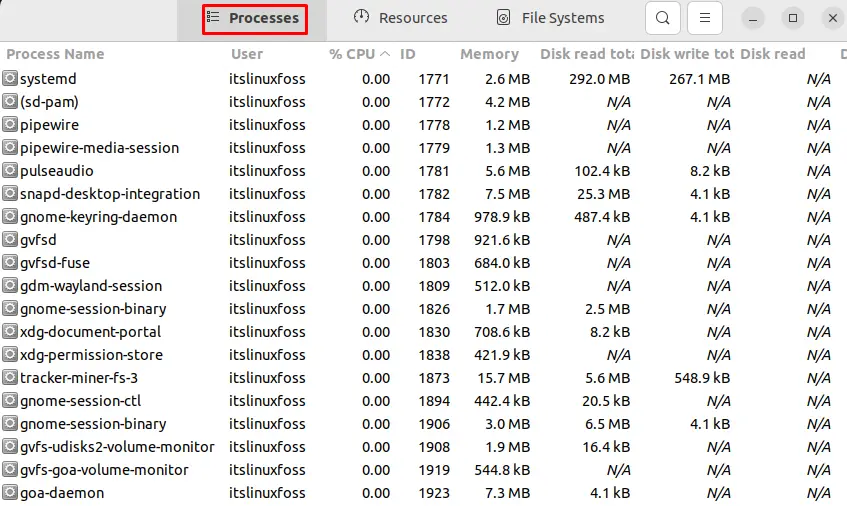
From this process monitoring functionality, the users can fetch the information using a few filters/conditions. Let’s see how they are carried out:
How to Monitor All the Processes From Task Manager?
To check all the running processes, you can click the icon “≡” (adjacent to the search bar). A new dropdown list will open with options to show “Active Processes”, “All Processes” and “My Processes”. Select the “My Processes” option. The information tabs (User, %CPU, ID, Memory, etc.) are the same as discussed earlier.
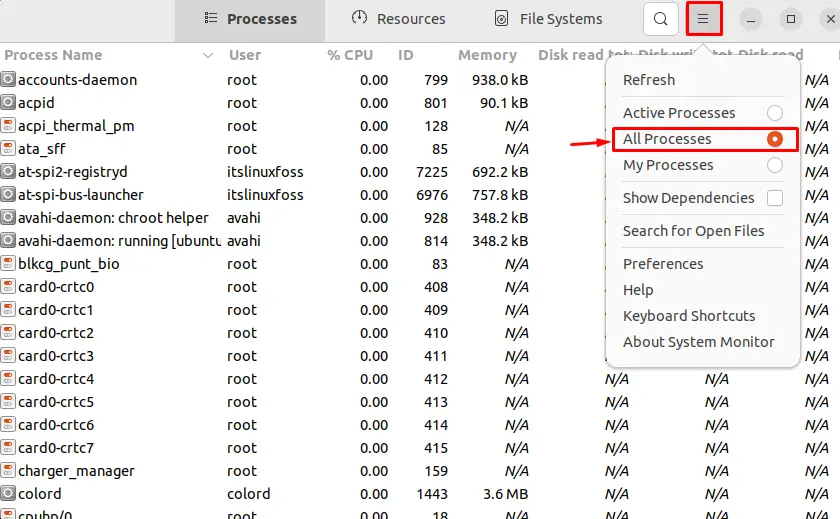
Note: If you have a lot of processes running on the system, click on the “Search for Open Files” option, and a search menu will open up where the users can search for their desired/required process.
How to Use Task Manager to Manage(Kill, Stop, Continue) a Process?
The Task Manager can be used to “Stop”, “Continue”, “Change Priority”, and “Kill”any process. To kill a process, select the required process and right-click to open the context menu. It will show different options; click “Kill”, and the process will be killed.
Note: You can also Stop or End a process click on “Stop” or “End” from the context menu.
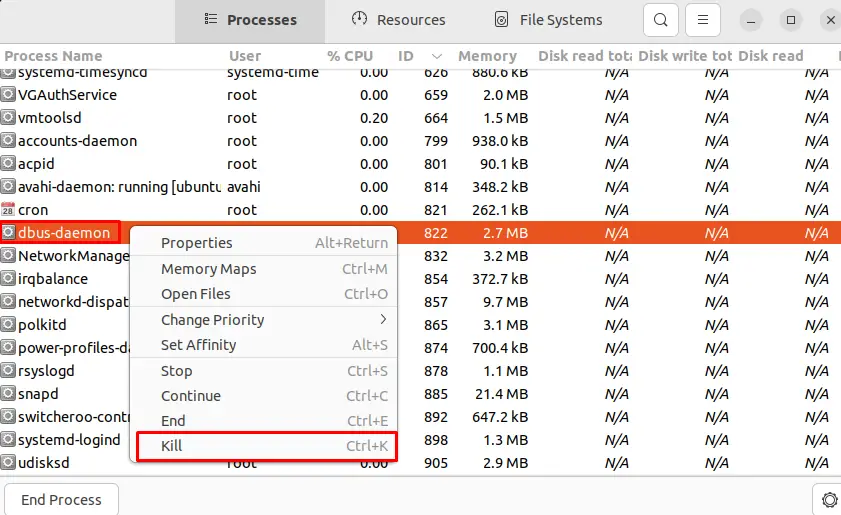
Note: Any process-related information, such as %CPU, ID, Memory, etc., can be sorted in ascending or descending order.
Use Task Manager For Monitoring System Resources
To monitor the system resources, click the “Resources” tab of the System Monitor (Task Manager). The resources tab displays the three plots for “CPU”, “Memory and Swap”, and “Network” which are described as:
- CPU graph is moving and showing the percentages concerning the load on “CPU” (Range: 0-100) over the “Time” (Range: 0-1 minutes).

- The Memory and Swap graph display the percentages of the memory & Swap consumption for the running processes over a “Time” of one minute.

- Moreover, the “Network” consumption plot shows the history and current “Receiving” & “Sending” speed to “Time”.

Use Task Manager For Monitoring File Systems
The Task manager is commonly used to monitor the files in a system. The “File Systems” tab of the Task Manager shows the details like the “Device”, “Type”of the device, “Total”, “Available”, and “Used” space for the Hard Disk of the system. From the “File Systems” tab, you can easily monitor the files and Hard Disk in a system.

That’s all from this guide!
Conclusion
System Monitor in Ubuntu 22.04 is used as Task Manager to monitor “File Systems”, “Resources”, and “Processes”. The “Processes” tab displays the details about the processes of the systems like “%CPU”, “Process ID”, “Memory consumption”, and “Priority”.The “Resources” tab displays the “CPU” load, “Memory and Swap” consumption, and “Network” usage/history. Moreover, the monitoring of the Hard Disk and files on the system can be done utilizing the “File System” tab of System Monitor.
